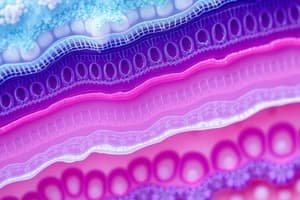Podcast
Questions and Answers
What is the primary role of areolar connective tissue?
What is the primary role of areolar connective tissue?
- Facilitating rapid muscle contraction
- Providing structural integrity to bones
- Insulating body organs
- Loose packing, support, and nourishment (correct)
Which of the following best describes the structure of areolar connective tissue?
Which of the following best describes the structure of areolar connective tissue?
- Solid structure with no flexibility
- Dense network of collagen without spaces
- Fine network of fibers with small spaces (correct)
- Fine network of fibers with large spaces
Where is areolar connective tissue primarily found in the body?
Where is areolar connective tissue primarily found in the body?
- Only in the dermis of the skin
- Between glands, muscles, and nerves (correct)
- In cartilaginous tissues
- Only in the brain
What type of cells are predominantly found within areolar connective tissue?
What type of cells are predominantly found within areolar connective tissue?
Which fibers are primarily present in areolar connective tissue?
Which fibers are primarily present in areolar connective tissue?
What is NOT a function of areolar connective tissue?
What is NOT a function of areolar connective tissue?
Which of the following statements about areolar connective tissue is true?
Which of the following statements about areolar connective tissue is true?
What role do fibroblasts play in areolar connective tissue?
What role do fibroblasts play in areolar connective tissue?
What type of epithelium consists of a single layer of cells that extends from the basement membrane to the free surface?
What type of epithelium consists of a single layer of cells that extends from the basement membrane to the free surface?
How many layers of cells are found in stratified epithelium?
How many layers of cells are found in stratified epithelium?
Which cell shape is characterized as being flat or scalelike?
Which cell shape is characterized as being flat or scalelike?
What type of epithelium appears to be stratified but is actually a simple layer with variations in cell shape?
What type of epithelium appears to be stratified but is actually a simple layer with variations in cell shape?
Which type of epithelium is specifically mentioned as allowing gas exchange in the lungs?
Which type of epithelium is specifically mentioned as allowing gas exchange in the lungs?
Which statement best describes cuboidal epithelium?
Which statement best describes cuboidal epithelium?
Which of the following correctly differentiates stratified epithelium from simple epithelium?
Which of the following correctly differentiates stratified epithelium from simple epithelium?
Which type of epithelium is capable of varying its shape based on the degree of stretch?
Which type of epithelium is capable of varying its shape based on the degree of stretch?
What is the primary structure of simple cuboidal epithelium?
What is the primary structure of simple cuboidal epithelium?
Which of the following functions is associated with simple cuboidal epithelium?
Which of the following functions is associated with simple cuboidal epithelium?
Where is simple cuboidal epithelium primarily found?
Where is simple cuboidal epithelium primarily found?
What type of cells may be present in simple cuboidal epithelium, particularly in kidney tubules?
What type of cells may be present in simple cuboidal epithelium, particularly in kidney tubules?
In the context of simple cuboidal epithelium, which part of the body utilizes ciliated cells?
In the context of simple cuboidal epithelium, which part of the body utilizes ciliated cells?
What is a key function of simple cuboidal epithelium in the choroid plexuses of the brain?
What is a key function of simple cuboidal epithelium in the choroid plexuses of the brain?
What type of transportation is commonly facilitated by simple cuboidal epithelium?
What type of transportation is commonly facilitated by simple cuboidal epithelium?
Which is NOT a characteristic of simple cuboidal epithelium?
Which is NOT a characteristic of simple cuboidal epithelium?
What is the primary function of muscle tissue?
What is the primary function of muscle tissue?
Which type of muscle is under voluntary control?
Which type of muscle is under voluntary control?
What characteristic distinguishes skeletal muscle cells?
What characteristic distinguishes skeletal muscle cells?
Where are skeletal muscles typically located in the body?
Where are skeletal muscles typically located in the body?
Which one of the following is NOT a type of muscle tissue?
Which one of the following is NOT a type of muscle tissue?
What describes the cellular structure of skeletal muscle fibers?
What describes the cellular structure of skeletal muscle fibers?
What is a major component of the contraction mechanism in muscle tissues?
What is a major component of the contraction mechanism in muscle tissues?
Which type of muscle tissue is found in the heart?
Which type of muscle tissue is found in the heart?
What is the primary function of cardiac muscle?
What is the primary function of cardiac muscle?
Which of the following describes the structural characteristics of cardiac muscle cells?
Which of the following describes the structural characteristics of cardiac muscle cells?
What type of control regulates cardiac muscle activity?
What type of control regulates cardiac muscle activity?
Where in the body is cardiac muscle located?
Where in the body is cardiac muscle located?
What feature connects cardiac muscle cells to one another?
What feature connects cardiac muscle cells to one another?
What is a key characteristic of intercalated disks in cardiac muscle?
What is a key characteristic of intercalated disks in cardiac muscle?
Which statement about cardiac muscle is correct?
Which statement about cardiac muscle is correct?
Which of the following best describes the nucleus of cardiac muscle cells?
Which of the following best describes the nucleus of cardiac muscle cells?
Flashcards are hidden until you start studying
Study Notes
Classification of Epithelia
- Epithelial layers can be classified as simple (single layer), stratified (multiple layers), or pseudostratified (appears to be stratified but is a single layer).
- Simple squamous epithelium allows easy passage of substances; critical for gas exchange in the lungs.
- Simple cuboidal epithelium consists of cube-shaped cells involved in active transport, secretion, and absorption; found in kidney tubules and glands.
- Pseudostratified columnar epithelium appears multi-layered due to varying cell shapes, although all cells are attached to the basement membrane.
Epithelial Cell Shapes
- Squamous cells are flat or scalelike.
- Cuboidal cells are cube-shaped, similar in height and width.
- Columnar cells are taller than they are wide, providing structural support.
Simple Squamous Epithelium
- Composed of a single layer of thin, flat cells; facilitates diffusion and filtration processes.
- Essential for respiratory gas exchange in the lungs.
Simple Cuboidal Epithelium
- Characterized by a single layer of cube-like cells; involved in secretion and absorption.
- Location includes kidney tubules, choroid plexuses, and various glands; may possess microvilli or cilia for enhanced function.
Areolar Connective Tissue
- Composed of a network of collagen and elastic fibers with spaces for cells like fibroblasts and macrophages.
- Provides loose packing, support, and nourishment; found widely in the body, including beneath epithelial layers and between organs.
Muscle Tissue Overview
- Functionally responsible for movement through contraction, facilitated by contractile proteins.
- Three main types: skeletal, cardiac, and smooth.
Skeletal Muscle
- Composed of striated (banded) muscle fibers that are long, cylindrical, and multinucleated.
- Under voluntary control and attached to the skeleton, allowing body movement.
Cardiac Muscle
- Found exclusively in the heart, characterized by cylindrical, striated cells with a single nucleus.
- Connected by intercalated disks containing gap junctions; functioning under involuntary control to pump blood.
Smooth Muscle
- Not detailed in current notes; generally, smooth muscle is non-striated, involuntary, and found in the walls of hollow organs.
Studying That Suits You
Use AI to generate personalized quizzes and flashcards to suit your learning preferences.




